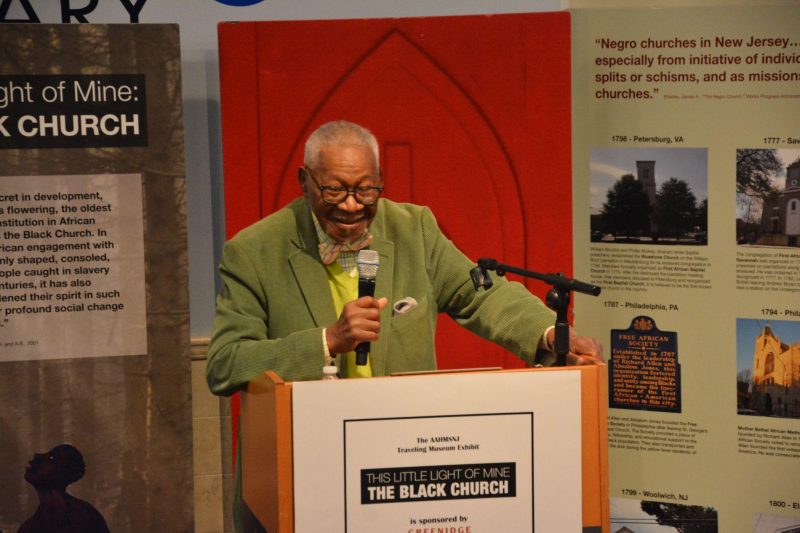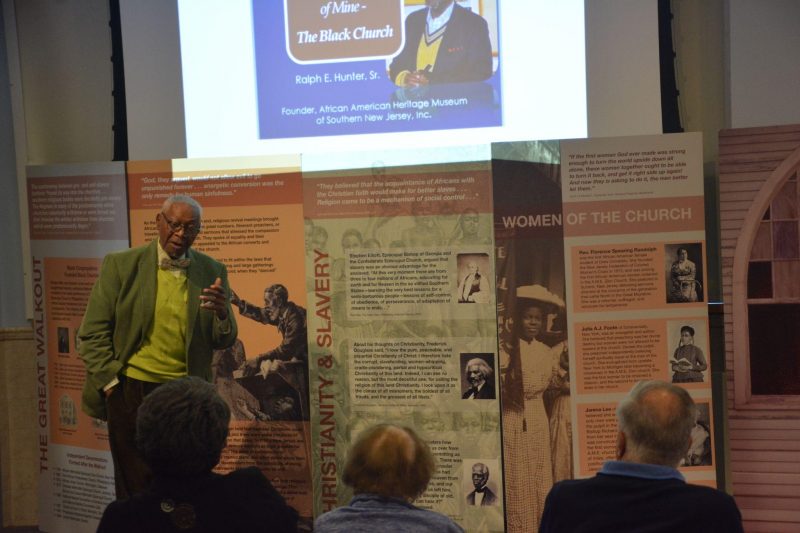Historian Ralph E. Hunter is the featured speaker at the Black History Month presentation in Ocean City. (Photos by Adriana Alfaro)
 By ADRIANA ALFARO
Ralph E. Hunter was raised by a ministry family. His grandfather, father and brother pursued great heights as priests.
So why didn’t Hunter pursue the ministry?
“Because I love history,” Hunter said.
Hunter, the African American Heritage Museum founder in Atlantic City, presented “This Little Light of Mine: The Black Church” at the Ocean City Free Public Library on Saturday as part of the annual Black History Month celebration.
The tall, cardboard displays presented stories, photographs and in-depth research about the development of Black churches across South Jersey and Philadelphia. The exhibit, as well as many others, could not have been completed without the help of students, volunteers and donors.
Hunter started his collection of artifacts of Black life in America in 1973 when he was 35 years old.
He had 3,000 pieces spread among his house and warehouses in New Jersey and Delaware. The first of which was a copy of Helen Bannerman’s “Little Black Sambo.”
Hunter purchased the book to remove it from the shelves since he had unpleasant recollections of it as a child.
The same book is now the focal point of a sizable collection of works of art, including paintings, pottery and artifacts related to advertising and branding that both flatteringly and unflatteringly depict African Americans. Some people may find them unpleasant.
By ADRIANA ALFARO
Ralph E. Hunter was raised by a ministry family. His grandfather, father and brother pursued great heights as priests.
So why didn’t Hunter pursue the ministry?
“Because I love history,” Hunter said.
Hunter, the African American Heritage Museum founder in Atlantic City, presented “This Little Light of Mine: The Black Church” at the Ocean City Free Public Library on Saturday as part of the annual Black History Month celebration.
The tall, cardboard displays presented stories, photographs and in-depth research about the development of Black churches across South Jersey and Philadelphia. The exhibit, as well as many others, could not have been completed without the help of students, volunteers and donors.
Hunter started his collection of artifacts of Black life in America in 1973 when he was 35 years old.
He had 3,000 pieces spread among his house and warehouses in New Jersey and Delaware. The first of which was a copy of Helen Bannerman’s “Little Black Sambo.”
Hunter purchased the book to remove it from the shelves since he had unpleasant recollections of it as a child.
The same book is now the focal point of a sizable collection of works of art, including paintings, pottery and artifacts related to advertising and branding that both flatteringly and unflatteringly depict African Americans. Some people may find them unpleasant.
 Ralph Hunter stands in front of displays chronicling the development of Black churches in South Jersey and Philadelphia.
Hunter started off his remarks by paying homage to entrepreneur Sarah Spencer Washington, who inspired him to visit Atlantic City. She opened a hair salon in Atlantic City in 1913 and eventually extended the operation by training pupils and creating cosmetics. She received recognition as one of the “Most Distinguished Businesswomen” at the 1939 New York World’s Fair.
He shared his experience of visiting Atlantic City for the first time while staying with his classmate.
“I saw police officers that looked like me, business owners that looked like me, and the nightlife was jumping. I knew I had to be here,” Hunter recalled.
He dove deep into topics such as the discriminatory practice of redlining, which withholds services from prospective consumers who live in areas deemed “dangerous” to investment and where there are disproportionately high concentrations of low-income and racial minority people.
He also spoke about “The Green Book,” which was an annual guidebook for African American road-trippers that provided information about hotels, boarding houses, taverns, restaurants and service stations. He also mentioned the origins of influential figures such as Oprah Winfrey and Fannie Lou Hammer.
“That’s the end game, you want to do good, you want to be good to your fellow neighbor. I don't care if you are a Christian or not, we have to be able to tell the story of how we overcame it,” Hunter said.
After Hunter’s lecture, guests were welcomed to ask questions. A reception was held afterward in the Ocean City Historical Museum and included the first look of the newest exhibit, “The Westside: Ocean City in True Color.”
Ralph Hunter stands in front of displays chronicling the development of Black churches in South Jersey and Philadelphia.
Hunter started off his remarks by paying homage to entrepreneur Sarah Spencer Washington, who inspired him to visit Atlantic City. She opened a hair salon in Atlantic City in 1913 and eventually extended the operation by training pupils and creating cosmetics. She received recognition as one of the “Most Distinguished Businesswomen” at the 1939 New York World’s Fair.
He shared his experience of visiting Atlantic City for the first time while staying with his classmate.
“I saw police officers that looked like me, business owners that looked like me, and the nightlife was jumping. I knew I had to be here,” Hunter recalled.
He dove deep into topics such as the discriminatory practice of redlining, which withholds services from prospective consumers who live in areas deemed “dangerous” to investment and where there are disproportionately high concentrations of low-income and racial minority people.
He also spoke about “The Green Book,” which was an annual guidebook for African American road-trippers that provided information about hotels, boarding houses, taverns, restaurants and service stations. He also mentioned the origins of influential figures such as Oprah Winfrey and Fannie Lou Hammer.
“That’s the end game, you want to do good, you want to be good to your fellow neighbor. I don't care if you are a Christian or not, we have to be able to tell the story of how we overcame it,” Hunter said.
After Hunter’s lecture, guests were welcomed to ask questions. A reception was held afterward in the Ocean City Historical Museum and included the first look of the newest exhibit, “The Westside: Ocean City in True Color.”
 "The Westside: Ocean City in True Color” exhibit at the Ocean City Historical Museum is inspired by a book by Loretta Thompson Harris.
“The Westside: Ocean City in True Color” is a trilogy written by fourth-generation Ocean City native Loretta Thompson Harris. It explores the unseen histories of the African American and Native American communities of Ocean City. The book is set to be published in April.
“Meet the everyday people, who spiked the rails, stoked the boilers, built the jetties, constructed the buildings, staffed the kitchen, and helped breathe life into this island resort” read the sign in front of the photographs and artifacts for the exhibit.
Harris is a former corporate executive who volunteers her time as a researcher for the Ocean City Historical Museum. She has also served on numerous boards and organizations.
Additionally, she has served as president of the Atlantic City Business and Professional Women as well as the National Association of Negro Businesses and Professional Women.
The Ocean City Historical Museum is housed inside the Ocean City Community Center at 1735 Simpson Avenue. More information is available by visiting ocnjmuseum.org.
The African American Heritage Museum is located at Stockton University’s Noyes Art Museum in Atlantic City. Additionally, the museum travels around the state to display its exhibits in schools, universities and establishments such as the Ocean Casino Resort and the Hard Rock Hotel & Casino in Atlantic City.
For more information, visit https://www.artsgarageac.com/african-american-heritage-museum.
"The Westside: Ocean City in True Color” exhibit at the Ocean City Historical Museum is inspired by a book by Loretta Thompson Harris.
“The Westside: Ocean City in True Color” is a trilogy written by fourth-generation Ocean City native Loretta Thompson Harris. It explores the unseen histories of the African American and Native American communities of Ocean City. The book is set to be published in April.
“Meet the everyday people, who spiked the rails, stoked the boilers, built the jetties, constructed the buildings, staffed the kitchen, and helped breathe life into this island resort” read the sign in front of the photographs and artifacts for the exhibit.
Harris is a former corporate executive who volunteers her time as a researcher for the Ocean City Historical Museum. She has also served on numerous boards and organizations.
Additionally, she has served as president of the Atlantic City Business and Professional Women as well as the National Association of Negro Businesses and Professional Women.
The Ocean City Historical Museum is housed inside the Ocean City Community Center at 1735 Simpson Avenue. More information is available by visiting ocnjmuseum.org.
The African American Heritage Museum is located at Stockton University’s Noyes Art Museum in Atlantic City. Additionally, the museum travels around the state to display its exhibits in schools, universities and establishments such as the Ocean Casino Resort and the Hard Rock Hotel & Casino in Atlantic City.
For more information, visit https://www.artsgarageac.com/african-american-heritage-museum.